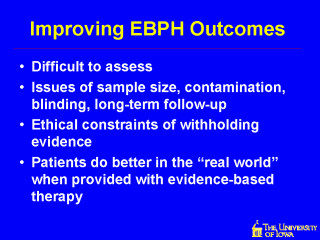| front |1 |2 |3 |4 |5 |6 |7 |8 |9 |10 |11 |12 |13 |14 |15 |16 |17 |18 |19 |20 |21 |22 |23 |24 |25 |26 |27 |28 |29 |30 |31 |32 |33 |34 |35 |36 |37 |38 |39 |40 |41 |review |
 |
It is important to improve our ability to know that an EBPH intervention achieved its desired outcome. However, formal evaluation of EBPH is difficult for the reasons listed in this slide. We do know, however, from outcomes research that patients do better in the "real world" when provided with evidence-based therapy (e.g., beta-blocker and aspirin after a heart attack; provision of recommended clinical preventive services). They also do worse when provided with therapy that lacks evidence (e.g., carotid endarterectomy patients not meeting EBM guidelines have a much higher risk of stroke and death). |